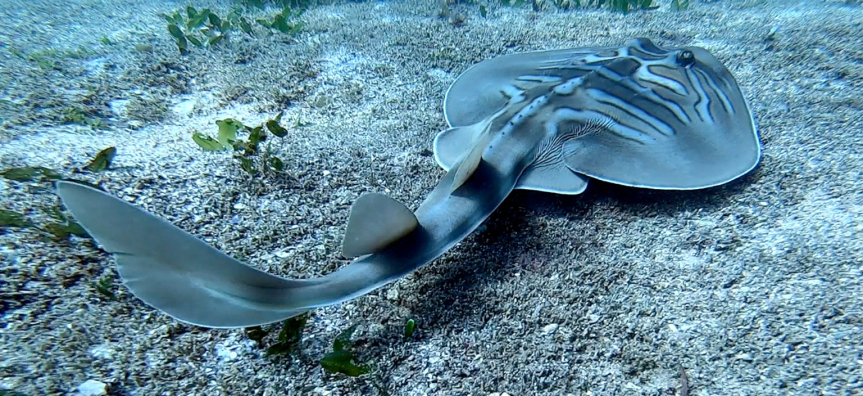
Life Below Water – Cabbage Tree Bay Aquatic Reserve
Rays
Interview with Sian Liddy, Marine Ecologist. Sian describes why Rays are important for Cabbage Tree Bay. The video contains overlay shots of Rays and Sian observing their behaviour underwater in the bay.
Video text transcript
Life Below Water – Cabbage Tree Bay Aquatic Reserve
Rays Video interview with Marine Ecologist Sian Liddy
(Sian is sitting on the rocks overlooking Cabbage Tree Bay. She describes why Cabbage Tree Bay is important for Rays. The video contains overlay shots of Rays and Sian observing their behaviour underwater in the bay.)
Sian Liddy:
Rays are closely related to sharks. They have this beautifully flattened shape that allows them to glide along the sea floor. They have these amazing structures that sit just behind their eyes that are known as spiracles. This allows them to suck water through and flush it through their gills and breathe, but they can also use it to hunt using electro receptions picking up on muscle contractions of different animals and then use a jet of water to flush away the sand, exposing that little prawn or worm and be able to grab it with their jaws which are at the bottom of their body.
Cabbage Tree Bay provides a lovely, sheltered habitat. At different times of year, you’ll see Fiddler Rays for example, coming in in April and May months. A really gorgeous animal and for me one of the highlights of going snorkelling here. These are a slightly different group as they don’t have a venomous barb at all.
We have quite a few different varieties of rays here at Cabbage Tree Bay. We have Eagle Rays, which have these beautiful diamond shaped wings. Sting Rays do have a venomous barb, though they only use this in self-defence. They are generally very gentle, very placid animals to be able to swim with.
We have a few special visitors who come to Cabbage Tree Bay at different times of the year. Cow Nose Rays come down from warmer subtropical and tropical waters. They are characterised by a beautiful bronze colour and a lovely heart shape just at the front of their nose.
Smooth Rays are one of the largest species we get here in the bay and they can grow to be a few meters in diameter. So, they are these beautiful large rays, but they are very placid and inquisitive in nature and are really just these gentle giants. If you get to see this ray in the bay, it’s really an excellent opportunity to interact with such a special, wild animal.
